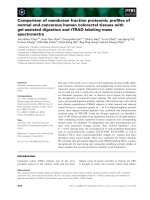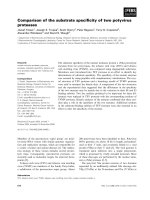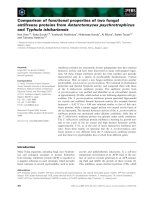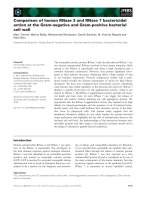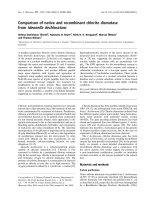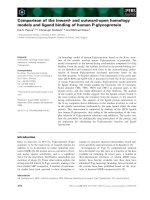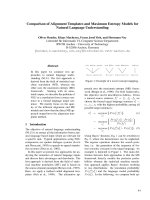Báo cáo khoa học: "Comparison of flexural and shear properties of southern pine LVL and lumber from young plantation and natural stands*" ppsx
Bạn đang xem bản rút gọn của tài liệu. Xem và tải ngay bản đầy đủ của tài liệu tại đây (702.65 KB, 9 trang )
Original
article
Comparison
of
flexural
and
shear
properties
of
southern
pine
LVL
and
lumber
from
young
plantation
and
natural
stands*
EJ
Biblis
School
of
Forestry,
Auburn
University,
Auburn,
AL
36849,
USA
(Receveid
24
August
1994;
accepted
30
April 1996)
Summary -
Edgewise
flexural
strength
and
stiffness
values
are
reported
of
southern
yellow
pine
(5.08
x
10.16
cm
2)
(2
x
4")
laminated
veneer
lumber
(LVL)
made
from
veneers
of
20-year-old
planta-
tion
trees,
veneer
of
28-
and
40-year-old
trees
of
natural
stands,
and LVL
composites
made
by
mixing
veneers
of
20-
and
40-year-old
trees.
The
obtained
flexural
properties
of
LVL were
correlated
to
veneer
thickness
and
grade
as
well
as
to
tree
age.
Flexural
and
shear
properties
of
LVL
are
compared
to
properties
of solid
lumber
obtained
from
the
same
groups
and
quality
of
trees.
The
distribution of
allowable
design
flexural
strength
’Fb’
and
stiffness
’E’
corresponding
to
SPIB-91
lumber
grades
of
various
LVL
groups
determined.
laminated
/ veneer
/ lumber
/ southern
pine
/ plantation
Résumé -
Comparaison
des
propriétés
en
flexion
et
cisaillement
de
poutres
de
bois
massif
reconstitué
et
de
bois
massif
de
pins
du
Sud
provenant
de
plantations
et
de
peuplements
naturels.
Des
poutres
en
bois
massif
reconstitué
(LVL)
sont
réalisées
à
partir
de
placages
déroulés
(section
5,08
x
10,16
cm
2)
de
pin
(Pinus
taeda
L).
Trois
type
de
poutres
sont
testées
en
flexion
sur
chant
et
en
cisaillement.
Elles
sont
réalisées
i)
à partir
de
placages
déroulés
dans
des
pins
de
plantation
âgés
de
20
ans,
ii)
à
partir
de
placages
d’arbres
âgés
de
28
et
40
ans
provenant
de
peuplements
naturels
et
iii)
en
mélangeant
des
placages
d’arbres
de
plantation
et
des
placages
d’arbres
de
40
ans.
Les
mesures
de
flexion
obtenues
sont
corrélées
à
l’épaisseur
des
placages
et
à
leur
classement
ainsi
qu’à
l’âge
des
arbres.
Les
propriétés
de
flexion
et
de
cisaillement
du
LVL
sont
comparées
aux
propriétés
du
bois
massif
mesurées
sur
des
arbres
comparables
en
âge
et
qualité.
Les
distributions
de
contrainte
admissible
(Fb)
et de
module
d’élasticité
admissible
(E)
qui
sont
définies
dans
les
règles
de
classement
du
LVL
(SPIB91)
sont
déterminées
et
présentées.
bois
massif
reconstitué
/ placage
déroulé
/ poutre
de
bois
massif
/ pin
du
Sud
/ plantation
*This
paper
is
based
on
a
study
supported
by
Mclntire-Stennis
funds
(Project
AL-974)
and
by
the
National
Research
Initiative
Grant
USDA-92-37103-8030
and
is
published
as
Alabama
Agricultural
Experiment
Station
journal
series
no
9-933491.
INTRODUCTION
It
has
been
reported
that
lumber
from
young
loblolly
and
slash
plantations
are
much
weaker
in
strength
and
stiffness
than
lumber
from
older
natural
stands
and
that
lumber
from
young
plantations
does
not
meet
the
design
requirements
for
the
visual
lumber
grades
(MacPeak
et
al,
1990;
Biblis et al,
1993).
This
is due to
the
fact
that
lumber from
younger
planted
trees
contain
large
percentages
of
fast
grown
’juvenile’ wood
and
a
large
number
and
size
of
knots
(Pearson
and
Gilmore,
1971,
1980;
Bendtsen,
1978;
Bendtsen
et al,
1986).
This
study
was
primarily
undertaken
to
in-
vestigate
whether
the
veneer
laminating
process
could
significantly
improve
the
properties
of
laminated
veneer
lumber
(LVL)
fabricated
from
veneers
of
20-year-
old
plantation
trees
as
compared
to
lum-
ber
properties
of
the
same
trees.
Addi-
tional
objectives
of
the
study
were
to
determine
the
properties
of
LVL
from
a
28-
and
a
40-year-old
natural
stand
and
compare
them
with
the
properties
of
the
LVL
from
the
20-year-old
plantation
stand.
Finally,
this
study
investigated
in
a
limited
way
the
degree
of
improve-
ment
in
flexural
properties
of
LVL
fabri-
cated
from
11
and
eight
veneer
plies
of
20-year-old
plantation
trees
reinforced
with
two
and
four
veneer
plies,
respec-
tively,
from
40-year-old
trees
of
natural
stand.
LVL
has
been
studied
and
commercially
produced
for
several
years
in
the
United
States
(Moody
and
Peters,
1972;
Nelson,
1972;
Koch,
1973;
Bohlen,
1975;
FPL,
1977;
Kunesh,
1978;
Laufenberg,
1983).
Present
production
of
LVL
utilizes
mostly
0.32
cm
(1/8
inch
["])
thick
veneers,
al-
though
veneers
0.25
cm
(1/10")
and
0.16
cm
(5/32")
thick
are
also
used.
The
main
reasons
for
the
commercial
production
of
long-length
LVL
with
veneer
scarf
or
over-
lap
staggered
joints
are
because
it
enables
production
of
boards
of
larger
width
and
length
than
sawn
lumber.
In
addition,
it
pro-
vides
relative
uniformity
in
strength
and
stiffness,
which
results
in
higher
design
strength
and
stiffness
values
than
sawn
lumber
produced
from
logs
of
the
same
species,
size,
age
and
quality.
The
impro-
vement
in
strength
and
stiffness
is
primarily
due
to
the
reduction
in
size
and
redistribu-
tion
of
defects
(knots
and
slope
of
grain)
by
the
laminating
process.
Another
reported
advantage
of
LVL
pro-
duction
is
the
improved
yield
of
lumber
(FPL,
1977;
Laufenberg,
1983).
The
impro-
vement
in
yield
is
due
to
kerfless
cutting
of
veneer.
However,
the
improvement
in
yield
alone
does
not
economically
justify
the
pro-
duction
of
LVL.
The
degree
of
improvement
in
strength
and
stiffness
by
the
laminating
process
does
not
justify
the
use
of
low
qua-
lity
logs
but
rather
logs
of
middle
or
high
quality
since
LVL
components
are
used
as
structural
members
requiring
high
design
values.
LVL
members
are
used
as
truss
components,
I-beam
flanges,
scaffold
planks
and
floor
joists.
LVL
members
can
be
also
produced
in
2.44
m
(8
foot
[’])
lengths
without
veneer joints
in
commercial
softwood
plywood
presses,
cut
them
into
lumber
and
then
finger-
or
scarf-joint
the
ends
into
longer
lengths.
Such
members
retain
most
of
the
previously
listed
advan-
tages
if
they
are
used
in
composite
struc-
tures
where
the
joints
are
allowed
to
distri-
bute
stresses
to
adjacent
materials,
as
in
the
case
of
flanges
of
wood
I-beams
and
laminated
built-up
beams.
A
study
by
Stump
et
al
(1981)
concerned
with
properties
of
LVL
produced
from
east-
ern
plantation
grown
conifers.
A
recent
stu-
dy
(Kretchamann
et
al,
1993)
investigated
properties
of
Douglas
fir
and
southern
yel-
low
pine
LVL
from
mature
and
juvenile
wood
veneers
of
the
same
nondestructive-
ly
determined
grade.
This
study
found
a
significant
difference
in
flexural
strength
and
stiffness
between
LVL from
mature
and
juvenile
veneers.
PROCEDURE
Materials
and
fabrication
Logs
2.59
m
(8.5’)
long
from
the
following
loblolly
pine
(Pinus
taeda
L)
forest
stands
in
Alabama
were
used
in
this
study:
i)
a
20-year-old
planta-
tion
with
original
spacing
2.44
x
2.44
m
(8
x
8’)
and
thinned
at
age
15;
ii)
a
28-year-old
natural
stand;
and
iii)
a
40-year-old
well-stocked
natural
stand.
Several
logs
from
each
of
these
stands
were
peeled
into
0.32
cm
(1/8")
thick
veneers
and
cut
into
1.32
m
(52")
wide
x
2.59
m
(102")
long
ve-
neer
sheets
in
a
southern
yellow
pine
plywood
mill.
In
addition,
some
logs
from
the
20-year-old
plantation
were
peeled
into
0.23
cm
(1/10")
thick
veneers.
All
veneers
from
each
group
and
thick-
ness
were
dried
in
the
mill
to
approximately
7%
moisture
content
(oven-dry
basis).
Dry
veneers
were
graded
according
to
American
Plywood
As-
sociation
standards
(1983).
Four
LVL
panels,
3.8
cm
(1.5")
thick
and
1.22
m
(4’)
wide
by
2.44
m
(8’)
long
were
fabricated
wi-
thout
veneer joints
from
each
of
the
first
five
LVL
groups
described
in
table
I,
while
only
one
LVL
panel
was
fabricated
from
each
of
the
’compo-
site’ LVL
groups
in
the
same
table.
Fabrication
of
each
panel
was
a
two-step
process
in
order
to
shorten
the
total
pressing
time
of
the
panels.
The
first
step
was
to
fabricate
a
1.9
cm
(3/4")
thick
panel
to
be
used
as
a
core
for
each
final
3.81
cm
(1.5")
thick
panel.
A
commercial
extended
phe-
nolic
resin
(the
same
used
by
the sawmill
in
the
fabrication
of
plywood)
was
applied
to
veneers
with
a
curtain
coater
at
a
rate
of
41.7
kg
(92
pounds)
per
92.9
m2
(1
000
square
feet)
of
dou-
ble
glue
line.
Those
core
panels
consisted
of
se-
ven
0.32
cm
(1/8")
veneers
or
eight
0.25
cm
(1/10")
veneers
and
were
first
prepressed
in
room
temperature
with
1
103
Kpa
(160
psi)
for
3
min.
Afterwards,
the
panels
were
hot
pressed
in
a
multiple
press
(one
panel
in
each
opening)
for
7.5
min
at
163
°C
with
1
379
Kpa
(200
psi).
The
second
step
for
fabricating
the
panels
of
the
first
five
groups
in
table
I consisted
of
laying
three
0.32
cm
(1/8")
B-
or
C-grade
veneers
of
0.95
cm
(0.375")
total
thickness
or
four
0.25
cm
(1/10")
veneers
then
placing
on
top
of
them
the
already
fabricated
1.9
cm
(3/4")
thick
core
panel
and
finally
laying
on
top
three
0.32
cm
(1/8")
or
four
0.25
cm
(1/10")
additional
veneers,
respec-
tively,
for
a
total
of
13
or
16
veneer
layers
in
each
panel
4.19
cm
(1.65")
thick.
The
second
step
for
fabricating
the
’composite
1’ panel
consisted
of
laying
one
B-grade
veneer
from
a
40-year-old
tree,
one
B-grade
and
one
C-grade
veneer
from
a
20-year-old
tree,
then
placing
on
top
the
already
fabricated
1.9
cm
(3/4")
thick
panel
and
finally
laying
on
top
three
additional
veneers
of
the
same
grades
and
age
on
the
three
veneers
at
the
bottom.
The
second
step
for
fabricating
the ’composite
2’ panel
was
similar
to
fabricating
’composite
1’
except
that
two
veneers
at
the
bottom
and
top
were
B-grade
veneers
from
a
40-year-old
tree
and
one
C-grade
veneer
from
a
20-year-old
tree.
All
assemblies
at
the
second
step
were
pre-pres-
sed
and
then
hot-pressed
with
the
same
sche-
dule
of
temperature,
time
and
pressure
as
the1.9
cm
(3/4")
thick
panel
in
the
first
step.
All
fabricated
panels
were
stacked-up
for
48
h
to
cool-off
before
sawing
them
into
lumber.
Astrip
5.08
cm
(2")
wide
was
removed
from
the
long
edge
of
each
panel
while
the
remaining
panel
was
sawed
into
12
LVL strips
9.14
cm
(3.6")
wide.
Each
LVL
strip
was
dressed
at
the
planer
to
cross-section
dimensions
3.81
x
8.89
cm
(1.5
x
3.5")
and
2.59
m
(102")
long.
Forty-eight
pieces
of
LVL
from
each
of
the
first
five
groups
and
12
pieces from
each
’composite’ panel
were
available
for
a
full-size
flexure
test.
Several
logs
2.59
m
(8.5’)
long
from
each
of
the
three
forest
stands
were
separated
and
end-
painted
with
different
colors
to
identify
each
stand.
All
logs
were
sawn
into
lumber
according
to
the
sawing
pattern
of
the
cooperating
sawmill.
All
lumber
was
kiln-dried
to
15%
MC.
All
lumber
of
various
sizes
was
dressed
to
final
dimensions
and
then
graded
by
the
mill’s
graders
according
to
Southern
Pine
Inspection
Bureau
(SPIB)
gra-
ding
rules
(1991).
Approximately
30
pieces
of
3.81
x
8.9
cm
(1.5
x
3.5")
lumber
from
each
of
the three
grades
(1,
2
and
3)
and
from
each
stand
were
separated
for
flexure
testing.
TESTING
The
following
properties
of
LVL
and
solid
sawn
lumber
were
evaluated.
Edgewise
flexural
strength
(modulus
of
rupture,
MOR)
and
edgewise
flexural
stiffness,
MOE)
From
each
LVL
panel
group
listed
in
table
I,
12
to
33
pieces
3.81
x
8.89
cm
(1.5
x
3.5")
were
test-
ed.
In
addition,
28
pieces
of
the
same
dimensions,
each
of
the
three
lumber
grades,
from
each
of
the
20-
and
28-year-old
stands
were
also
test-
ed.
All
edgewise
flexural
tests
were
made
to
fai-
lure
according
to
ASTM
D-198
(1991)
with
third-
point
loading
over
a
span
of
2.29
m
(90")
as
indicated
in
figure
1.
After
testing,
the
moisture
content
percentage
(MC)
and
specific
gravity
(SG)
of
each
tested
piece
were
determined
from
a
cross-sectional
sample
taken
in
the
vicinity
of
the
failure.
Flatwise
flexural
strength
(MOR)
and
flatwise
flexural
stiffness
(MOE)
From
each
LVL tested
piece
in
edgewise
flexure,
except
for
composites,
an
undamaged
section,
58.4
cm
long,
was
taken
and
tested
in
flexure
flat-
wise
to
failure
according
to
ASTM
D-143
(1991)
with
central
loading
over
a
span
of
53.3
cm
(21").
Wood
block
shear
strength
From
each
LVL
group
listed
in
table
I,
except
for
composites,
approximately
60
wood
block
shear
specimens
were
prepared
to
test
the
shear
strength
perpendicular
to
the
glue
line.
The
test
was
done
according
to
the
ASTM
D-143
test
me-
thod
(1991).
In
addition,
approximately
48
wood
block
shear
strength
specimens
were
prepared
from
lumber
representing
the
20-year-old
stand
and
48
spe-
cimens
representing
the
28-year-old
stand.
The
test
was
done
according
to
the
ASTM
D-143
test
method
(1991).
RESULTS
AND
DISCUSSION
The
flexural
properties
of
the
LVL
tested
groups
are
listed
in
table
I while
the
flexural
properties
of
the
solid
sawn
lumber
from
the
three
forest
stands
are
listed
in
table
II.
The
results
indicate
the
following:
The
flexural
properties
MOR
and
MOE
of
LVL
from
the
20-year-old
plantation
are
signifi-
cantly
(differences
of
the
means
tested
with
t-test
and
found
significant
at
the
99%
level)
lower
than
corresponding
properties
of
LVL
fabricated
from
veneers
of
older
natural
stands.
The
average
edgewise
MOR
of
the
20-year-old
LVL’s
P20-13
BC
and
P20-16
BC
(36 296
KPa
or
5
264
psi)
is
only
68
and
53%
of
the
edgewise
MOR
values
of
LVL
from
the
28-
and
40-year-old
natural
stands,
respecti-
vely.
Similarly,
the
average
MOE
of
LVLs
of
the
20-year-old
plantation
is
only
73%
and
63%
of
edgewise
MOE
values
of
LVL
from
the
28-
and
40-year-old
natural
stands,
res-
pectively.
The
same
tendency
exists
in
the
flatwise
flexural
properties.
Table
I
also
indicates
that
the
average
MOR
value
of
the
20-year-old
plantation
LVL
with
thinner
veneer
plies
0.25
cm
(1/10")
is
slightly
greater
than
that
of
LVL
with
0.32
cm
(1/8")
thick
veneers.
However,
the
reverse
is
true
concerning
the
edgewise
MOE
values.
The-
refore,
the
results
do
not
indicate
a
favorable
effect
of
veneer
thick-ness
on
flexural
proper-
ties
of
LVL
based
on
veneer
thicknesses
considered
in
this
study.
The
edgewise
flexural
MOE
of
every
LVL
group
in
this
study
(table
I)
is
between
39
and
55%
larger
than
the
flatwise
flexural
MOE
of
each
group.
This
can
be
explained
by
the
fact
that
the
edgewise
stiffness
was
determined
with
third-point
loading,
a
me-
thod
which
eliminates
shear
deflection
be-
tween
the
loading
points
and
thus
gives
hi-
gher
MOE
values.
On
the
other
hand,
the
flatwise
strength
(MOR)
of
every
LVL
group
is,
on
average,
25%
greater
than
the
edge-
wise
MOR
value
in
each
group.
There
is
a
significant
(differences
of
the
means
tested
with
t-test
and
found
signifi-
cant
at
the
99%
level)
effect
of
B-
and
C-
grade
veneers,
especially
on
the
MOR
va-
lues
and
on
the
MOE
of
LVL
from
the
40-
year-old
natural
stand.
The
LVL
produced
from
the
B-grade
veneers
is,
on
average,
18%
stronger
than
LVL
produced
from
the
C-grade
veneers.
The
average
edgewise
flexural
proper-
ties,
MOR
and
MOE,
of
the
composites
are
significantly
higher
than
the
corresponding
properties
of
LVL
representing
the
20-year-
old
trees.
Composite
1
with
a
15%
of
the
total
volume
in
B-grade
veneer
from
40-
year-old
trees,
provides
an
increase
of
23%
in
MOR
and
17%
in
MOE.
Composite
2
with
a
31 %
of
the
total
volume
in
B-grade
veneer
from
40-year-old
trees,
provides
an
in-
crease
of
35%
in
MOR
and
22%
in
MOE.
The
average
edgewise
flexural
properties
of
LVL
from
the
20-year-old
plantation
shown
in
table
I are
between
the
corresponding
va-
lues
of
sawn
lumber
grades
No
1
and
No
2
from
logs
of
the
same
stand
shown
in
table II.
On
the
basis
of the
average
MOE
value
alone
(8
874
MPa
or
1
287
928
psi
of
LVL
P20-
16BC),
these
specimens
do
not
qualify
to
be
graded
even
as
a ’standard’
SPIB
grade
(the
lowest
of
all
grades).
If
we
consider
the
com-
bined
MOE
value
9
417
MPa
(1 365 829
psi)
of
both
LVL
groups,
P20-13BC
and
P20-
16BC,
then
combine
them
as
one
group,
on
the
basis
of
stiffness
value
alone,
they
qualify
only
as
a
’standard’
SPIB
grade.
Table
III
shows
that
95%
of
the
LVL
pieces
made
from
20-year-old
trees
with
0.32
cm
(1 /8")
thick ve-
neers
(P20-13BC)
have
design
values
for
bending
’Fb’
(calculated
for
every
tested
piece
by
dividing
the
MOR
value
of
every
piece
by
the
2.1
adjustment
factor
recom-
mended
in
ASTM
D245-88
[1991])
and
’E’
that
belong
to
SPIB
lumber
2 none
dense
and
lower.
Table III
also
shows
that 93%
of
the
LVL
pieces
made
with
0.42
cm
(1/6")
thick
ve-
neers
(P20-16BC)
have
design
values
that
belong
to
the
lowest
SPIB
lumber
’stand-
ard’
grade.
Thus,
it
appears
that
fabrication
of
LVL
from
the
20-year-old
plantation
does
not
provide
any
improvement
over
the
pro-
perties
and
design
values
of
the
sawn
solid
lumber
of
this
material.
The
average
edgewise
flexural
properties
of
LVL
from
the
28-year-old
natural
(N28-
13BC)
stand
shown
in
table
I (MOE
= 12
994
MPa
or
1
884 588
psi;
MOR
=
53
540
KPa
or
7
765
psi)
are
larger
than
the
corresponding
properties
for
grade
2
lumber
of
the
same
stand
shown
in
table
II.
Table
III
indicates
56%
of
the
LVL
pieces
of
the
same
stand
have
design
values
for
bending
equal
to
SPIB
grade
’dense
select
structural’
(Fb
=
21
029
Kpa
or
3
050
psi;
MOE
=
13
100
MPa
or
1.9
Mpsi),
20%
of
the
pieces
with
design
value
equal
to
lumber
grade
2
and
better
and
24%
of
the
pieces
with
design
value
equal
to
lum-
ber
of
’standard’
grade.
Table
III
also
shows
that
100%
of
the
LVL
pieces
tested
from
the
40-year-old
natural
stand
have
design
values
for
bending
equal
to
SPIB
grade ’dense
se-
lect
structural’.
It
appears
therefore
that
the
laminating
process
to
produce
LVL
from
trees
of
older
than
28-year-old
natural
stands
improves
the
properties
and
design
values
of
sawn
lumber
from
trees
of
these
stands.
Table
III
also
shows that 67%
of
the
tested
LVL specimens
of
composite
1
have
design
values
that
belong
to
lumber
grade
1
and
better.
This
table
indicates
that
67%
of
the
tested
LVL
specimens
of
composite
2
have
design
values
that
belong
to
lumber ’select
structural’
grade
and
better.
This
finding
indicates
that
a
significant
structural
improvement
can
be
made
by
rein-
forcing
LVL
made
from
20-year-old
plantation
trees
with
four
B-grade
veneers
(31 %
of
LVL
volume)
of
40-year-old
mature
trees.
The
shear
strength
of
LVL
specimens
per-
pendicular
to
the
glue
line
of
LVL
from
the
20-year-old
plantation
was
7
695
KPa
or
1
116
psi
and
8
667
KPa
or
1 257
psi
for
the
0.32
cm
(1/8")
and
0.25
cm
(1/10")
thick
veneer,
respectively,
as
shown
in
table
IV.
These
values
are
approximately
equal
to
shear
strength
of
solid
sawn
wood
8
171
KPa
(1
185
psi)
from
logs
of
the
same
stand.
The
shear
strength
of
LVL
perpendi-
cular
to
grain
from
the
28-year-old
natural
stand
was
9
350
KPa
(1
356
psi).
This
va-
lue,
however,
is
only
78%
of
the
shear
strength
value
of
solid
sawn
wood
11
950
KPa
(1
733
psi)
from
logs
of
the
same
stand.
The
lower
shear
strength
value
of
the
LVL
can
be
explained
by
the
possible
effect
of
the
veneer
lathe
checks
in
the
LVL.
This,
however,
needs
to
be
verified
with
ad-
ditional
well
controlled
experiments.
CONCLUSION
The
results
of
this
study
indicate
that:
i)
The
edgewise
flexural
properties
MOR
and
MOE
of
LVL fabricated
from
the
20-year-old
plantation
are
significantly
lower
than
cor-
responding
properties
of
LVL
fabricated
from
veneers
of
older
natural
stands.
The
average
MOR
and
MOE
values
of
LVL from
the
20-year-old
trees
are
only
54
and
63%,
respectively,
of
the
properties
of
LVL
from
40-year-old
trees
from
natural
stands.
ii)
There
is
a
significant
effect
of
the
veneer
grades
(B
and
C
grades)
particularly
on
the
flexural
strength
of
LVL
from
40-year-old
trees,
where LVL
made
with
B-grade
ve-
neers
is,
on
average,
is
18%
stronger
than
LVL
made
from
C-
grade
veneers.
iii)
Fabri-
cation
of
LVL
from
20-year-old
plantation
trees
does
not
provide
improvement
over
the
properties
and
design
values
of
N°
1
and
2
sawn
solid
lumber of this
material.
iv)
Inclusion
of
veneer
from
mature
trees
signi-
ficantly
improved
the
strength
and
stiffness
of
LVL
made
exclusively
from
20-year-old
plantation
trees.
Inclusion
of
31%
of
B-
grade
veneers
from
a
mature
tree
to
69%
B-
and
C-grade
veneers
from
20-year-old
plantation
trees
significantly
improved
the
flexural
strength
of
the
composite
LVL
by
35%,
compared
to
LVL
made
exclusively
from
veneers
of
20-year-old
plantation
trees.
v)
The
shear
strength
of
LVL
perpen-
dicular
to
the
glue
line
from
the
20-year-old
trees
are
not
significantly
different
from
the
shear
strength
value
of
solid
wood
speci-
mens
from
the
same
trees.
vi)
The
shear
strength
of
LVL
perpendicular
to
glue
line
from
the
40-year-old
trees
from
the
natural
stand
are
significantly
higher
than
the
shear
strength
of
LVL
from
the
20-year-old
plantation
trees.
REFERENCES
American
Plywood
Association
(1983)
US
Product
Standard
for
construction
and
industrial
plywood.
P
51-83.
Tacoma,
WA,
USA
American
Society
for
Testing
and
Materials
(ASTM)
(1991)
Standard
methods
of
static
tests
of
timbers
in
standard
sizes,
D
198-84.
Standard
method
of
testing
small
clear
specimens
of
timber
D
143-83.
In:
American
Book
of ASTM
Standards,
Section
4,
vol
04.09,
Philadelphia,
PA,
USA
Bendtsen
BA,
Senft
J
(1986)
Mechanical
and
anatomi-
cal
properties
in
individual
growth
rings
of
plantation-
grown
eastern
cottonwood
and
loblolly
pine.
Wood
Fiber Sci
18,
23-38
Bendtsen
BA
(1978)
Properties
of
wood
from
improved
and
intensively
managed
trees.
Forest
Prod
J
28,
61-72
Biblis
EJ,
Brinker
R,
Carino
H,
McKee
CW
(1993)
Effect
of
stand
age
on
flexural
properties
and
grade
com-
pliance
of
lumber
from
loblolly
pine
plantation
timber.
Forest
Prod J
43,
23-28
Bohlen
JC
(1975)
Shear
strength
of
Douglas-fir
lamina-
ted-veneer lumber.
Forest Prod J 25,
16-23
FPL
Press-Lam Research
Team
(1977)
Progress
in
Te-
chnical
Development
of
Laminated
Veneer
Structu-
ral
Products.
USDA
Forest
Service
Res
Pap
FPL
279.
Forest
Prod
Lab,
Madison,
WI,
USA
Koch
P (1973)
Structural lumber
laminated
from
1/4
inch
rotary-peeled
southern
pine
veneer.
Forest
Prod
J
23,
17-25
Kretchamann
DE,
Moody
RC,
Pellevin
RF,
Bendtsen
BA,
Cahill
JM,
McAllister
RH,
Sharp
DW
(1993)
The
effect
of
various
proportions
of juvenile
wood
on
LVL.
USDA
FPL
RP-521.
Forest
Products
Lab,
Madison,
WI,
USA
Kunesh
RH
(1978)
MICRO = LAM:
structural
laminated
veneer
lumber.
Forest
Prod J
28,
41-44
MacPeak
MD,
Burkart
LF,
Weldon
D
(1990)
Comparison
of
grade,
yield,
and
mechanical
properties
of
lumber
produced
from
young
fast-grown
and
older
slow-
grown
planted
slash
pine.
Forest
Prod
J 40,
11-14
Pearson
RG,
Gilmore
RC
(1980)
Effect
of
fast
growth
rate
on
the
mechanical
properties
of
loblolly
pine.
Forest
Prod
J
30,
47-54
Pearson
RG,
Gilmore
RC
(1971)
Characterization
of
the
strength
of
juvenile
wood
of
loblolly
pine
(Pinus
tae-
da
L).
Forest
Prod
J
21,
23-30
Laufenberg
TL
(1983)
Parallel-laminated
veneer
pro-
cessing
and
performance
research
review.
Forest
Prod
J
33,
21-28
Moody
RC,
Peters
CC
(1972)
Strength
properties
of
rotary
knife-cut
laminated
southern
pine.
USDA
Fo-
rest
Serv,
Res
Pap
FPL
178,
Forest
Products
Lab,
Madison,
WI,
USA
Nelson
SA
(1972)
Structural
applications
of
MICRO-
=
LAM
lumber.
Civ
Eng
42,
57
Southern
Pine
Inspection
Bureau
(1991)
Grading Rules.
SPIB, Pensacola,
FL,
USA
Stump JP,
Smith
LA,
Gray
RL(1981)
Laminated Veneer
Lumber
made
from
plantation-grown
conifers.
For
Prod
J
31,
35-40
